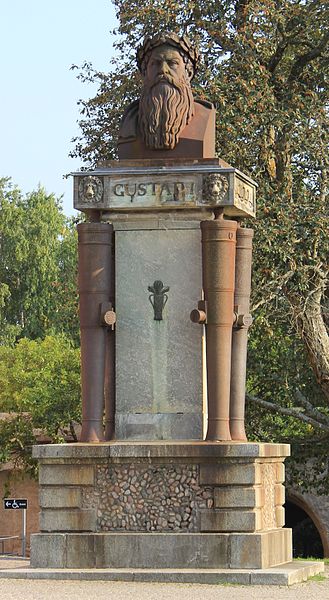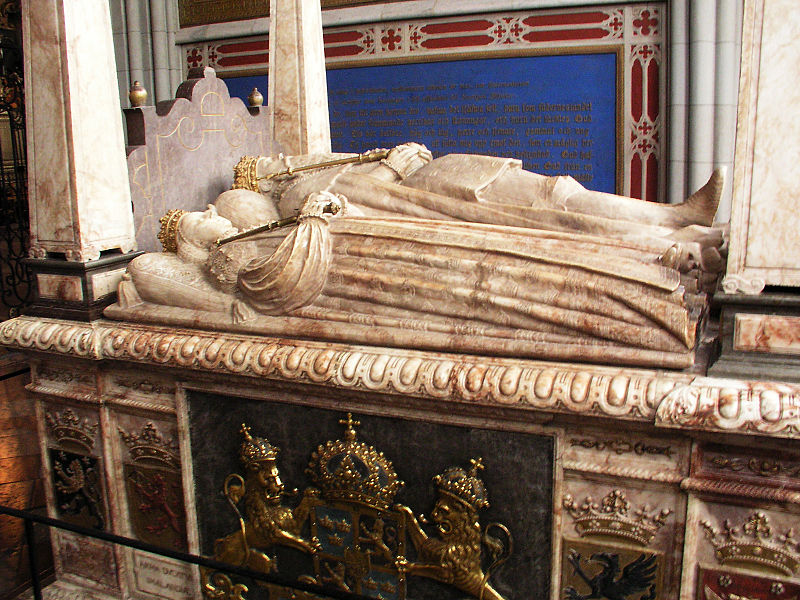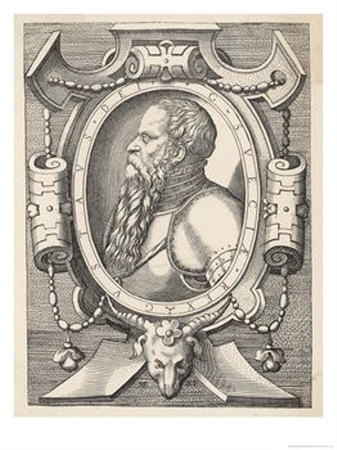<Back to Index>
- King of Sweden Gustav I Eriksson, 1496
PAGE SPONSOR
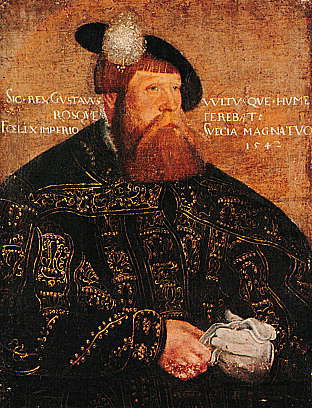
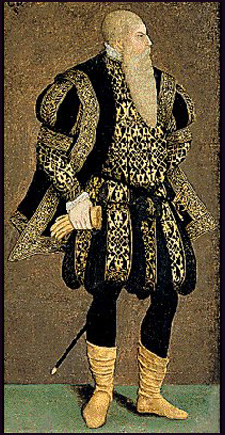
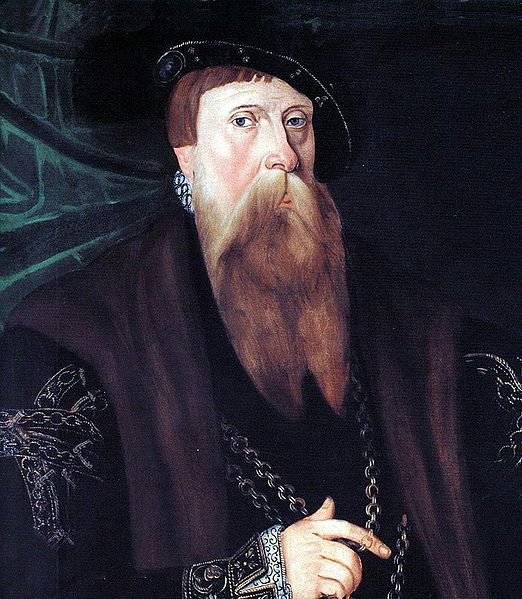
Gustav I of Sweden, born Gustav Eriksson of the Vasa noble family and later known simply as Gustav Vasa (12 May 1496 – 29 September 1560), was King of Sweden from 1523 until his death.
He was the first monarch of the House of Vasa, an influential noble family which came to be the royal house of Sweden for much of the 16th and 17th centuries and the first dynasty to rule by law as hereditary monarchs of Sweden. Gustav I was elected regent in 1521 after leading the Swedish War of Liberation against Christian II of Denmark, the leader of the Kalmar Union who controlled most of Sweden at the time.
Gustav was an enigmatic person who has been referred to both as a liberator of the country and as a tyrannical ruler. When he came to power in 1523, he was largely unknown, and he became the ruler of a still divided country without a central government. He became the first truly autocratic native Swedish sovereign and was a skilled propagandist and bureaucrat who laid the foundations for a more efficient centralized government and legally established a hereditary monarchy, in place of the previous electoral kingship where certain dynasties traditionally had been eligible. During his reign Protestantism was introduced in the country.
In traditional Swedish history he has been labelled the founder of modern Sweden, and the "father of the nation". Gustav liked to compare himself to Moses, whom he believed to have also liberated his people and established a state. As a person, Gustav was known for ruthless methods and a bad temperament, but he also loved music, and had a certain sly wit.
Gustav founded one of the now oldest orchestras of the world, the Kungliga Hovkapellet (Royal Court Orchestra). Royal housekeeping accounts from 1526 mention twelve musicians including wind players and a timpanist but no string players. Today the Kungliga Hovkapellet is the orchestra of the Royal Swedish Opera.
Gustav Eriksson, a son of Cecilia Månsdotter Eka and Erik Johansson Vasa, was probably born in 1496. The birth most likely took place in Rydboholm Castle, northeast of Stockholm, the manor house of the father, Erik. The newborn got his name, Gustav, from Erik's grandfather Gustav Anundsson.
Erik Johansson's parents were Johan Kristersson and Birgitta Gustafsdotter of the dynasties Vasa and Sture respectively, both dynasties of high nobility. Birgitta Gustafsdotter was the sister of Sten Sture the Elder, regent of Sweden. Being a relative and ally of uncle Sten Sture, Erik inherited the regent's estates in Uppland and Södermanland when the latter died in 1503. Although a member of a family with considerable properties since childhood, Gustav Eriksson would later be the holder of possessions of a much greater dimension.
According
to genealogical research, Birgitta Gustafsdotter and Sten Sture (and
consequently also Gustav Vasa) were descended from King Sverker II of Sweden, through King Sverker's granddaughter Benedikte Sunesdotter (who was married to Svantepolk Knutsson, son of Duke of Reval).
Since the end of the 14th century, Sweden had been a part of the Kalmar Union with
Denmark and Norway. The Danish dominance in this union occasionally led
to uprisings in Sweden. During Gustav's childhood, parts of the Swedish
nobility tried to make Sweden independent. Gustav and his father Erik
supported the party of Sten Sture the Younger, regent of Sweden from 1512, and its struggle against the Danish king Christian II. Following the battle of Brännkyrka in 1518, where Sten Sture's troops beat the Danish forces, it was decided that Sten Sture and king Christian would meet in Österhaninge for
negotiations. To guarantee the safety of the king, the Swedish side
sent six men as hostage to be kept by the Danes for as long as the
negotiations lasted. However, Christian did not show up for the
negotiations, violated the deal with the Swedish side and took the
hostages aboard ships carrying them to Copenhagen. The six members of the kidnapped hostage were Hemming Gadh,
Lars Siggesson (Sparre), Jöran Siggesson (Sparre), Olof Ryning,
Bengt Nilsson (Färla) - and Gustav Eriksson. Gustav was held in Kalø slot where
he was treated very well after promising he would not make attempts to
escape. A reason for this gentle treatment was king Christian's hope to
convince the six men to switch sides, and turn against their leader Sten
Sture. This strategy was successful regarding all men but Gustav, who
stayed loyal to the Sture party.
In 1519, Gustav Eriksson escaped from Kalø. He fled to the Hanseatic city of Lübeck where he arrived on 30 September. How he managed to escape is not certain, but according to a somewhat likely story, he disguised himself as a bullocky. For this, Gustav Eriksson got the nicknames "King Oxtail" and "Gustav Cow Butt", something he indeed disliked. When a swordsman drank to His Majesty "Gustav Cow Butt" in Kalmar 1547, the swordsman was killed.
While staying in Lübeck, Gustav could hear about the development in his native Sweden. He could notice that Christian II mobilized to attack Sweden in an effort to seize the power from Sten Sture and his supporters. In 1520, the forces of king Christian were triumphant. Sten Sture died in March, but some strongholds, including the Swedish capital Stockholm, were still able to withstand the Danish forces. Gustav left Lübeck on a ship, and were put ashore south of Kalmar on 31 May.
It seems Gustav stayed pretty inactive the first months back on Swedish soil. According to some sources, Gustav received an invitation to the coronation of Christian. This was to take place in the newly captured Stockholm in November. Even though king Christian had promised amnesty to his enemies within the Sture party, including Gustav Eriksson, the latter chose to decline the invitation. The coronation took place on 4 November and days of festivities in a friendly spirit followed. When the celebration had lasted a few days, the castle was locked and the former enemies of king Christian were imprisoned. Accusations against the old supporters of Sten Sture regarding heresy were brought forward. The following day the sentences were announced. During Stockholm Bloodbath, as the events became known as, close to 100 people were executed on Stortorget, among them relatives of Gustav Eriksson. His father, Erik Johansson, and nephew, Joakim Brahe, were two of the executed. Gustav himself was at the time staying at Räfsnäs close to Gripsholm Castle.
Gustav Eriksson had reasons to fear for his life and left Räfsnäs. He traveled to the province of Dalarna,
in what was then northwestern Sweden. What happened there has been
described in Peder Svart's chronicle, which can be described as a
strongly biased heroic tale about Gustav Eriksson. The Dalarna
adventures of Gustav that could be described as a part of the national
heritage of Sweden, can therefore not be verified in a satisfying way.
He is supposed to have tried to gather troops among the peasantry in the
province, but with little success initially. Being chased by men loyal
to king Christian and failing at creating an army to challenge the king,
Gustav Eriksson had no other alternative but to flee to Norway. While he made his way from Mora via Lima to
Norway, people that had recently turned down Gustav's call for support
against the king changed their minds. Representatives of that group
caught up with Gustav before he had reached Norway and convinced him to
follow them back to Mora. Gustav Eriksson's run towards Norway and back
has formed the background to the famous cross country ski race Vasaloppet.
Gustav Eriksson was appointed hövitsman. The rebel force he led grew. In February 1520 it consisted of 400 men, mainly from the area around Lake Siljan. The first big clash in the Swedish War of Liberation that now started, took place at Brunnbäck's Ferry in April, where the rebels defeated a troop loyal to the king. Neither in this battle nor in later battles during the war, did Gustav take part in leading the military operations. The revolting insurgents had further success. Other parts of Sweden, for example the Götaland provinces of Småland and Västergötland, also saw rebellions. The leading noblemen of Götaland joined the force of Gustav Eriksson and, in Vadstena in August, they declared Gustav regent of Sweden.
The election of Gustav Eriksson as a regent made many Swedish nobles, that so far had stayed loyal to king Christian, switch sides. Some noblemen, still loyal to the king, chose to leave Sweden, while others were killed. As a result, the Swedish Privy Council lost old members who were replaced by supporters of Gustav Eriksson. Most fortified cities and castles were conquered by Gustav's rebels, but the strongholds with best defense, including Stockholm, were still under Danish control. In 1522, after negotiations between Gustav Eriksson's people and Lübeck, the Hanseatic city joined the war against Denmark. The winter of 1523 saw the joined forces attack the Danish and Norwegian areas of Scania, Halland, Blekinge and Bohuslän. During this winter, Christian II was overthrown and replaced by Frederick I. The new king openly claimed the Swedish throne and had hopes Lübeck would abandon the Swedish rebels. The German city, preferring an independent Sweden to a strong Kalmar Union dominated by Denmark, took advantage of the situation and put pressure on the revolting side. The city wanted privileges on future trade as well as guarantees regarding the loans they had granted the rebels. The Privy Council and Gustav Eriksson knew the support from Lübeck was absolutely crucial. As a response, the council decided to appoint Gustav Eriksson king.
The ceremonious election of the regent Gustav Eriksson as king of Sweden was made when the leading men of Sweden got together in Strängnäs in June 1523. When the councilors of Sweden had chosen Gustav as king, he met with the two visiting councilors of Lübeck. The German representatives supported the appointment without hesitation and declared it as being an act of God. Gustav stated he had to bow to what was described as the will of God. In a meeting with the Privy Council, Gustav Eriksson announced his decision to accept. In the following ceremony, led by the deacon of Strängnäs, Laurentius Andreae, Gustav swore the royal oath. The next day, bishops and priests joined Gustav in Roggeborgen where Laurentius Andreae raised the holy sacrament above a kneeling Gustav Eriksson. Flanked by the councilors of Lübeck, Gustav Eriksson was brought to Strängnäs Cathedral where the king sat down in the choir with the Swedish privy councilors on one side, and the Lübeck representatives on the other. After the hymn "Te Deum", Laurentius Andreae proclaimed Gustav Eriksson king of Sweden. He was, however, still not crowned. In 1983, in remembrance of the election of Gustav as Swedish king on 6 June, that date was declared National Day of Sweden.
Shortly after the events in Strängnäs, a letter patent was issued to Lübeck and its allied Hanseatic cities, who now were freed from toll when trading in Sweden. An agreement, designed by Lübeck negotiators, was made with the Danish defenders in Stockholm. On 17 June the rebels could enter the capital city. At Midsummer, a grand entrance of king Gustav was arranged at Söderport, the southern gate of Stockholm. Celebrations followed, including a mass of thanksgiving in Storkyrkan (also known as Stockholm Cathedral) led by Peder Jakobsson. Gustav could now install himself in the Tre Kronor palace.
Bailiffs, loyal to the old king Christian, were still holding castles in Finland, a part of Sweden at the time. During the summer and fall of 1523 they all surrendered. The
next year, on 24 August 1524, Gustav arrived in Malmö in order to
reach a settlement with Denmark and its king Frederick. The Treaty of Malmö (in Swedish: Malmö recess)
had both positive and negative sides to it, from king Gustav's
perspective. The treaty meant that Denmark - Norway acknowledged the
independence of Sweden. The hopes Gustav had carried of winning further
provinces (Gotland and Blekinge) were however scuttled. The treaty
marked the end of the Swedish War of Liberation.
After Gustav seized power, the previous Archbishop, Gustav Trolle, who at the time held the post of a sort of chancellor, was exiled from the country. Gustav sent a message to Pope Clement VII requesting the acceptance of a new archbishop selected by Gustav himself: Johannes Magnus.
The Pope sent back his decision demanding that unlawful expulsion of Archbishop Gustav Trolle be rescinded, and that the archbishop be reinstated. Here Sweden's remote geographical location proved to have a marked impact — for the former Archbishop had been allied with the Danish king, or at least was considered to have been so allied in contemporary Stockholm, and to reinstate him would be close to impossible for Gustav.
The king let the Pope know the impossibility of the request, and the possible results if the Pope persisted, but — for better or worse — the Pope did persist, and refused to accept the king's suggestions of archbishops. At the time, incidentally and for different reasons, there were also four other unoccupied bishop's seats, where the king made suggestions to the Pope about candidates, but the Pope only accepted one of the candidates. Because the Pope refused to budge on the issue of Gustav Trolle, the king, influenced by Lutheran scholar Olaus Petri, in 1531 took it upon himself to appoint yet another archbishop, namely the brother of Olaus, Laurentius Petri. With this royal act, the Pope lost any influence over the Swedish Church.
In the 1520s, the Petri brothers led a campaign for the introduction of Lutheranism. The decade saw many events which can be seen as gradual introductions of Protestantism, for instance the marriage of Olaus Petri — a consecrated priest — and several texts published by him, advocating Lutheran dogmas. A translation of the New Testament had also been published in 1526. After the reformation, a full translation was published in 1540 - 41, called the Gustav Vasa Bible. However, knowledge of Greek and Hebrew among Swedish clergymen was not sufficient for a translation from the original sources; instead the work followed the German translation by Martin Luther in 1534.
Gustav I's breaking with the Catholic Church is virtually simultaneous with Henry VIII doing
the same in England; both kings acted following a similar pattern,
i.e., a prolonged confrontation with the Pope culminating with the king
deciding to take his own decisions independently of Rome.
Gustav encountered resistance from some areas of the country. People from Dalarna rebelled three times in the first ten years of Gustav's reign, as they considered the king to have been too harsh on everyone he perceived as a supporter of the Danish, and as they resented his introduction of Protestantism. Many of those who had helped Gustav in his war against the Danes became involved in these rebellions and paid for this, several of them with their lives.
People in Småland rebelled in 1542, and initially gave Gustav severe difficulties in the dense forests. The king sent a letter to the people of Dalarna, requesting that they should send out letters to every Swedish province, stating that Dalarna would support the king with troops, and urging every other province to do the same. Gustav got his troops, with whose help - and paid German mercenaries - he managed to defeat the rebels next spring.
The leader of the rebels, Nils Dacke, has traditionally been seen as a traitor to Sweden. His own letters and proclamations to fellow peasants focused on the suppression of Roman Catholic customs of piety, the King's requisitions of church bells and church plate to be smelted down for money and the general discontent with Gustav's autocratic measures, and the King's letters indicate that Dacke had considerable military success for several months. Historical records state that Nils was seriously wounded during a battle, taking bullet wounds to both legs; if this is true, his survival may have been surprising in view of contemporary medical techniques. Some sources state that Nils was executed by quartering; others that he was reduced to the state of an outlaw after recovering from his wounds, and killed while trying to escape through the woods on the border between Småland and then Danish Blekinge. It is said that his body parts were displayed throughout Sweden as a warning to other would - be rebels; this is uncertain though his head was likely mounted on a pole at Kalmar. Modern Swedish scholarship has toned down criticism of Nils Dacke, sometimes making him into a hero in the vein of Robin Hood, particularly in Småland.
Difficulties
with the continuation of the Church also troubled Gustav Vasa. The
1540s saw him imposing death sentences upon both the Petri brothers, as
well as his former chancellor Laurentius Andreae. All of them were however granted amnesty, after spending several months in jail. In 1554 – 1557, he waged an inconclusive war against Ivan the Terrible of Russia.
In the late 1550s, Gustav's health declined. When his grave was opened in 1945, an examination of his corpse revealed that he had suffered chronic infections of a leg and in his jaw.
He gave a so - called "last speech" in 1560 to the chancellors, his children and other noblemen, whereby he encouraged them to remain united. On 29 September 1560, Gustav died and was buried (together with three of his wives, while only two are engraved) in the Cathedral of Uppsala.
Gustav's heritage has been disputed. In 19th century Swedish history a folklore
developed wherein Gustav was supposed to have had all kinds of
adventures when he liberated Sweden from the Danes. The memory of Gustav
has been honored greatly, resulting in embroidered history books, commemorative coins, and the annual ski event Vasaloppet (the largest ski event in the world with 15,000 participants). The city of Vaasa in Finland was named after the royal house of Vasa in 1606. Gustav is currently portrayed on the 1000 kronor note.
Today most of these stories are considered to have no other foundation
than legend and skilful propaganda by Gustav himself during his time.
Here is an example of one of his better known adventures among the Swedish people. While Gustav was in exile from the Danish army, he was staying at a farm owned by a close friend for a day's rest. As he was warming himself in the common room, the Danish soldiers got a tip from one of the farm hands that Gustav was in his landlord's farm house. The Danish soldiers burst into the farm house and began searching in the common room for someone that would fit Gustav's description. As one of the soldiers came close to check Gustav Vasa, all of a sudden the landlady took out a bakery spade and started to hit Gustav and scolded him as a "lazy farmboy" and ordered him to go out and work. The Danish soldier found it amusing and did not realize this "lazy farmboy" was in fact Gustav Vasa himself who managed to slip away from danger and escape death. There are many other stories about Gustav's close encounters with death, however it is questionable if any of his adventures really did happen or were dramatized by Gustav himself; regardless of whether they happened or not, his adventures are still told to this day in Sweden.
Gustav
has been regarded by some as a power hungry man who wished to control
everything: the Church, the economy, the army and all foreign affairs.
But in doing this, he also did manage to unite Sweden, a country that
previously had no standardized language, and where individual provinces
held a strong regional power. He also laid the foundation for Sweden's
professional army that was to make Sweden into a regional superpower in
the 17th century.
In 1739, English playwright Henry Brooke wrote the play Gustavus Vasa, dealing with the liberation of Sweden from Danish rule. However, Robert Walpole, British Prime Minister at the time, believed that the play's villain was intended to represent him, and had the play banned - the first English play to be so banned under the Licensing Act 1737.
Later in the 18th century, the name Gustavus Vasa was given to Olaudah Equiano, a prominent African ex - slave living in Britain and involved in the struggle to abolish slavery.
Gustav Vasa had a series of paintings made during his reign. The originals are lost but watercolor reproductions
of unknown date remain. These paintings show Gustav's triumphs, showing
what Gustav himself considered important to depict.
